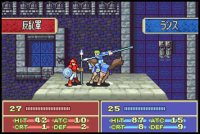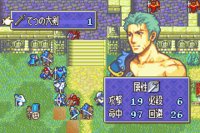|
|

|
PLATFORM
|
GBA
|
BATTLE SYSTEM
|

|
INTERACTION
|

|
ORIGINALITY
|

|
STORY
|

|
MUSIC & SOUND
|

|
VISUALS
|

|
CHALLENGE
|
Hard
|
COMPLETION TIME
|
20-40 Hours
|
|
OVERALL

|
+ Effective dose of solid tactical combat
+ Links with the first English FE are interesting
+ Difficult without being overwhelming
- Item management outside of battle isn't great
- Support system is somewhat constrained
- Roy spends a lot of time as dead weight
|
Click here for scoring definitions
|
|
|
Back when the GameCube was a new commodity, Nintendo teased consumers by including two characters from the Fire Emblem series in Super Smash Bros. Melee. One of them, Marth, was already established in Japan and would eventually see his adventure reach other shores in Fire Emblem: Shadow Dragon. The other was Roy, whose game hadn't even been released in Japan at the time of SSBM. As things transpired, Nintendo never saw fit to localize Fire Emblem: Fuuin no Tsurugi (The Sealed Sword), leaving it to the next game in the series for a proper introduction across the Pacific. Fortunately for any interested in Roy's story, his game is a worthy entry into the Fire Emblem series, and the region-free Game Boy Advance allows easy importing.
The Sealed Sword's tale takes place twenty years after that of the first English Fire Emblem. It finds Zephiel having taken the throne of Bern, then seeking to conquer the entire continent. Into this scenario falls Roy, who leads the fight against Bern's ambitions. Zephiel's motivation is a little different than the standard world-conqueror, but most of the plot is a fairly standard slew of locations with bad guys who must be shown the sharp end of a blade before they get the point.
More interesting than the core events are those that detail the changes among the seventh game's cast. Being set twenty years after the events of the first English Fire Emblem means that some of the same people appear, albeit with age usually having hindered their aptitude in combat. Many children of now-deceased characters from the earlier setting also aid in combat, which is the main bother of the game remaining in Japanese. Translations of the entire game text are easy to find, however, and with a full understanding of the conversations taking place, the connections between this game and its prequel are quite interesting.
When it comes to the nuts and bolts of playing the game, veterans of the later English Fire Emblem games on GBA will find themselves completely at home. Newcomers to the series are not necessarily advised to start with The Sealed Sword, but its combat and interface are not difficult to understand after a brief time to become acclimated. Looking like many other tactical RPGs, this Fire Emblem title finds the player maneuvering Roy and his allies to clear a battlefield of foes, then trying to survive when the enemies get their own turn. Various types of weapons and magic exist, almost all of which will wear out and break with repeated use. The series mainstay of having characters who lose all their HP in battle die is here and a moment's inattention will often result in someone coming down with a permanent case of death. The game helpfully displays how an encounter will play out before the player commits to any action, and monitoring enemy move ranges is easily done, though time-consuming.
 Dramatic freeze-framed action! Will Lance succeed in sticking it to this grunt soldier? Find out next time!
Dramatic freeze-framed action! Will Lance succeed in sticking it to this grunt soldier? Find out next time!
|
|
A strength of the Fire Emblem series is its relative simplicity compared to some other tactical franchises, and The Sealed Sword certainly keeps that aspect. Everything moves quickly and efficiently, from switching weapons on the fly to the choosing of a target. The menus are arranged identically to those in the later GBA Fire Emblem titles, but even someone unfamiliar with those will find progressing through the battlefields to be easily comprehensible.
One aspect that would be significantly improved in the next Fire Emblem title is its Support system. Certain characters who stand next to each other in battle, after a number of turns, will be able to have conversations that enhance their abilities when standing within three turns of the partner. What The Sealed Sword institutes is a hidden limit on the Support points that can be accumulated in each chapter, which severely constrains any effort to quickly pair characters. The Support system of the later GBA games is hardly ideal, but at least the player is not prevented from using it as much as possible in those.
Dragging around a main character that can't contribute much to the fighting is not unique to The Sealed Sword, but Roy has a couple of points that make him rather frustrating. The first is his absurdly late promotion point in the game, which makes him unable to contribute much to the fighting once his unpromoted form has reached the maximum level, especially when every other character can be promoted long before Roy. The second comes from the necessity of making him march over every map, since every battle except the last one requires Roy to conquer the throne its boss occupies. Roy isn't completely worthless in the early and later parts of the game, since only he can wield a couple of very useful weapons, but the time he spends as dead weight is difficult to overlook.
Item management is simple enough for the most part, and it is only in comparison to later games in the series that it has issues. One of those issues is the inability to use an item outside of combat, which forces a character to enter battle with a promotion item instead of a fifth weapon. Another annoyance comes from being forced to move items to character inventories in order to sell them, instead of simply divesting them from the storage facility. While these aspects are bothersome, The Sealed Sword still has a relatively good inventory system that allows all characters (except Roy) to be moved around in pre-battle placement, swap items freely, change equipment at any time, and look at the enemy's equipment and abilities. By the standards of the series, this isn't a pinnacle, but it's also not the ditch of the earliest games. Judging The Sealed Sword by the standards of the later GBA games isn't entirely fair, however, since it was released before them and kept from the English-speaking world by Nintendo's inaction.
 Veterans of the first English Fire Emblem will have no problem acclimating.
Veterans of the first English Fire Emblem will have no problem acclimating.
|
|
The Sealed Sword's difficulty is slightly higher than its successor game, but anyone who found the first English Fire Emblem manageable won't have a problem here. There are a fair amount of dangerous enemies with high critical rates later in the game, but it is possible to exploit the AI in order to minimize this danger. Getting to the real finale of the game could be difficult without looking at a FAQ, but it's not a cryptic endeavor that will be completely impenetrable. There are a couple of route splits, plus a Hard Mode, to provide replay value.
The visuals of all three GBA Fire Emblem games are very similar, as Intelligent Systems reused sprites from this one later. As the first time these sprites appeared, they don't use the system's capabilities to its fullest, but they certainly get the job done with panache. The sound effects were also reused in the later GBA titles. As to the music, it is in keeping with its successor games, having some catchy tunes and a few tiresome ones.
Fire Emblem: The Sealed Sword is not the best game in the series, but neither is it the worst. When compared with its prequel, this game comes up a little bit short, but most definitely provides a worthy tactical title. Challenging without being maddening, with a good variety of locations, and an ample number of replay incentives. Had it been the introduction the English-speaking world was given to Fire Emblem, it would have done a good job of establishing the series, but it's definitely worth checking out for anyone not instantly scared off by its Japan-only status.
Review Archives
|









